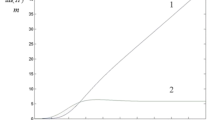Summary
The problem of tidal friction as a cause of the secular deceleration of earth rotation was higherto approached on the basis of estimating the kinetic energy dissipated by bottom friction. It would appear however, that in any analysis of the influence of oceanic tides on earth rotation the varying directions of the torques due to tidal streams and acting on the solid earth, must be taken into account. As examples for this, the torques due to tidal friction are calculated for the North Sea and for the 10°-world ocean, applying hydrodynamical-numerical methods. The results show that earth rotation is not retarded at all points of the world ocean, but that tidal areas exist exerting either decelerating or accelerating forces.
Similar content being viewed by others
Literatur
F. Gondolatsch,Erdrotation, Mondbewegung und das Zeitproblem der Astronomie, Veröff. Astr. Recheninst. Heidelberg5 (1953).
J. W. Wells,Paleontological evidence of the rate of the earth's rotation. The earth-moon system, Ed.B. G. Marsden, A. G. W. Cameron (Plenum-Press, 1966).
W. H. Munk andG. F. J. MacDonald,The rotation of the earth (Cambridge Univ. Press, 1960).
A. Defant,Physical oceanography, Vol. II (Pergamon Press, 1961).
nG. I. Taylor,Tidal friction in the Irish Sea, Phil. Trans. Roy. Soc. [A]220 (1919).
H. Jeffreys,Tidal friction in shallow seas, Phil. Trans. Roy. Soc. [A]221 (1920).
Die Reproduktion der Bewegungsvorgäne im Meere mit Hilfe Hydrodynamisch-numerischer Verfahren, Mitt. Inst. Meereskd. Univ. Hamburg5 (1966).
Atlas der Gezeitenströme für die Nordsee, den Kanal und die Britischen Gewässer, Dt. Hydr. Inst. Hamburg (1963).
W. Hansen,Gezeiten und Gezeitenströme der halbtägigen Hauptmondtide M 2 in der Nordsee, Dt. Hydr. Zeitschr. Ergänzungsheft1 (1952).
P. Brosche undJ. Sündermann,Gezeitenreibung und Erdrotation, Die Naturwiss.56, 3 (1969).
W. Zahel,Die Reproduktion der Gezeiten des Weltozeans mittels der hydrodynamisch-numerischen Methode (in Vorbereitung).
C. I. Pekeris andY. Accad,Solution of Laplace's equations for the M 2-tide in the world oceans, Proc. Roy. Soc. [A]265 (1969).
P. Melchior,Earth tides, inEncyclopaedic dictionary of physics, Suppl. Vol. 3 (Pergamon Press).
W. Hansen,Theorie zur Errechnung des Wasserstandes und der Strömungen in Randmeeren nebst Anwendungen, Tellus8 (1956).
J. Sündermann,Ein Vergleich zwischen der analytischen und numerischen Berechnung winderzeugter Strömungen und Wasserstände in einem Modellmeer mit Anwendungen auf die Nordsee, Mitt. Inst. Meereskd. Univ. Hamburg4 (1966).
G. Brettschneider,Anwendung eines im Institut für Meereskunde der Universität Hamburg entwickelten Verfahrens zur numerischen Ermittlung von Gezeiten in Randmeeren auf die M 2-Mitschwingungsgezeit in der Nordsee, Mitt. Inst. Meereskd. Univ. Hamburg7 (1967).
L. von Trepka,Anwendung des hydrodynamisch-numerischen Verfahrens zur Ermittlung des Schelfeinfiusses auf die Gezeiten in Modellkanälen und Modellozeanen, Mitt. Inst. Meereskd. Univ. Hamburg9 (1967).
Author information
Authors and Affiliations
Rights and permissions
About this article
Cite this article
Brosche, P., Sündermann, J. Die Gezeiten des Meeres und die Rotation der Erde. PAGEOPH 86, 95–117 (1971). https://doi.org/10.1007/BF00875078
Received:
Issue Date:
DOI: https://doi.org/10.1007/BF00875078




